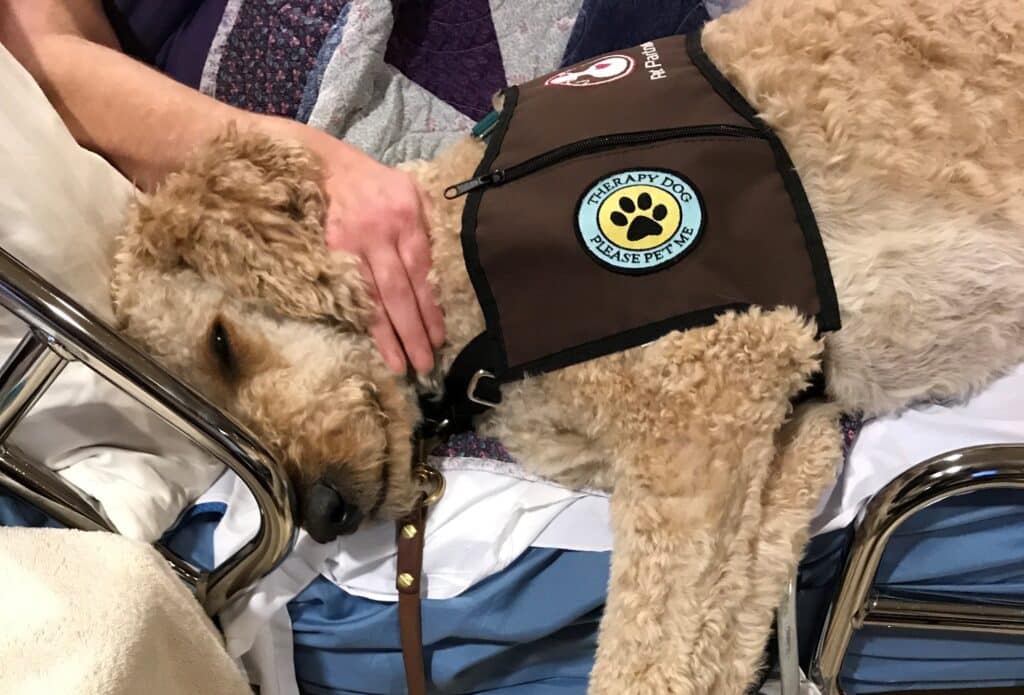



Pet Partners therapy animal teams visit in a huge variety of facilities and environments. While people most often think of hospital visits and reading programs as settings for therapy animals, there’s really no limit to the places where therapy animal teams can have an impact. We want to share more information about these diverse settings and the experiences that teams have visiting in them, to help demonstrate how broad the impact of therapy animal visiting can be. We’re pleased to welcome a guest post from handler Caryn Friedlander with her reflections on visiting with her therapy dog in a hospice setting.
I’ve been a hospice volunteer for about fifteen years, three of them as a therapy animal team with my beautiful goldendoodle, Tashi. An experience I had years ago made it clear that adding a dog into the mix could enhance my work.
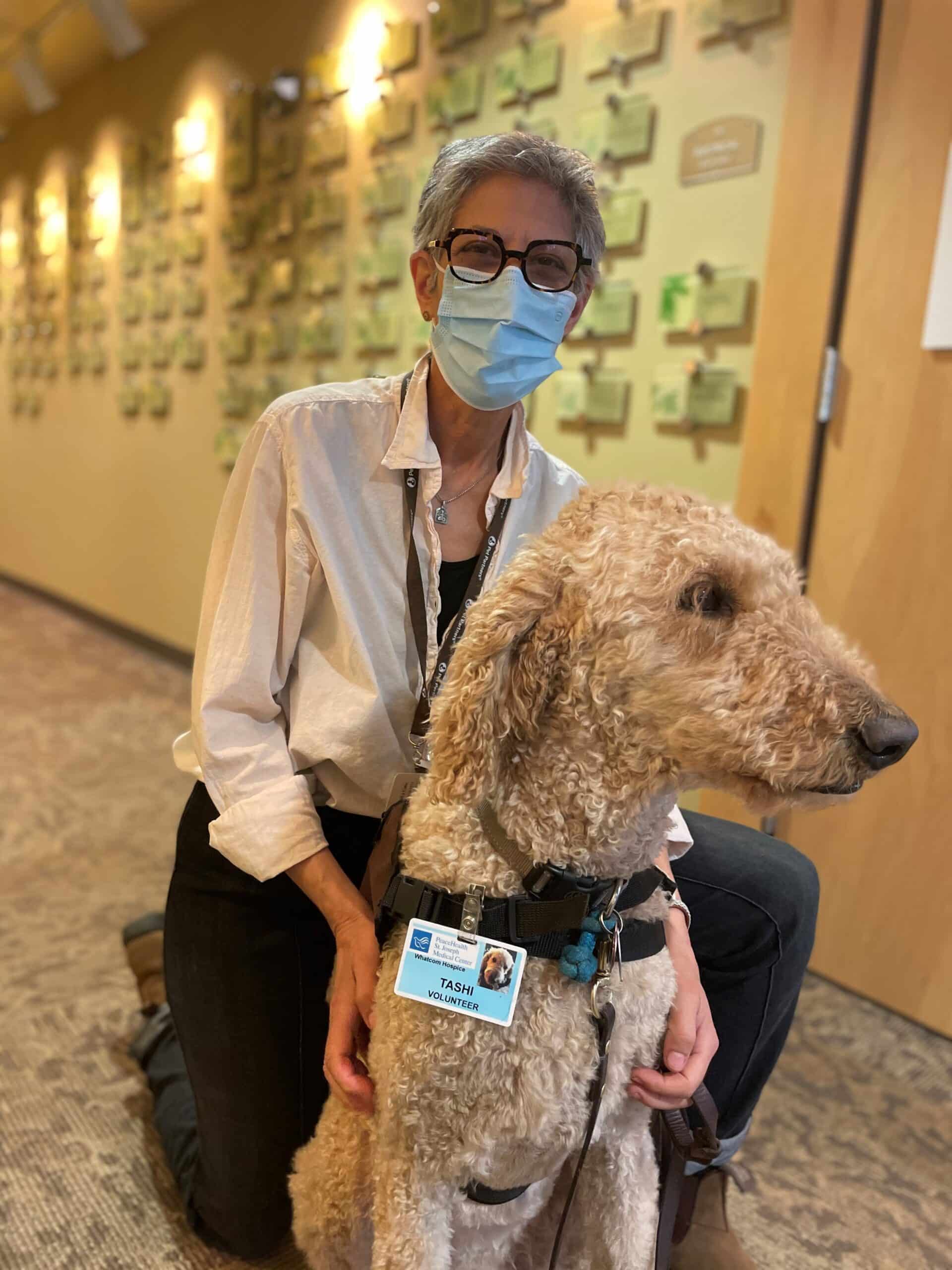
I had taken a friend’s dog along to visit a hospice client at an assisted living facility. When I walked through the facility’s lounge, the entire atmosphere changed; a mostly silent roomful of people turned into a beehive of chatter, requests to meet the guest (the dog, not me), and smiles all around. The people in the room, mostly withdrawn into their private worlds, started to connect with each other. I’m sure that for many therapy animal handlers, this comes as no surprise. But for me it opened up a new world.
I decided right then that I would do this work with my own dog one day. Ten years later, I was fortunate to find the right dog to partner with. Tashi is gentle, responsive, capable of joyfully interacting but also of being a quiet presence, as circumstances merit. He doesn’t mind being hugged, or draped over by children, and he stands at attention like the rest of us for the leaving ceremonies we do when a person dies at hospice.
When I tell people that I volunteer at hospice, I sometimes hear comments about how difficult or sad that must be. Likewise, the idea of being a therapy animal team at hospice surprises some; as a case in point, I was asked to write this post in part to comment on the differences between working in the hospice setting as opposed to bringing my dog to a hospital.
I’ve never worked with Tashi in a hospital environment, so I called the hospital volunteer coordinator to discuss where their therapy animal teams work and what they do. I thought her insight would make the differences apparent, and I came away thinking there are many parallels, and a few subtle differences.
Therapy animal teams at the hospital visit people in the ICU and palliative care units as well as waiting rooms and other inpatient units, where they provide the same services that Tashi and I do. The emotions that accompany people in hospitals and hospices are similar. Stress, grief, anxiety, and fear all exist as part of the hospital experience, as they do in a hospice setting. Our intent as therapy animal teams is to help mitigate that suffering by offering a moment of comfort and normalcy in a time and place of uncertainty. Animals are marvelous at giving a moment of rest from these emotional states, no matter what venue they serve in.
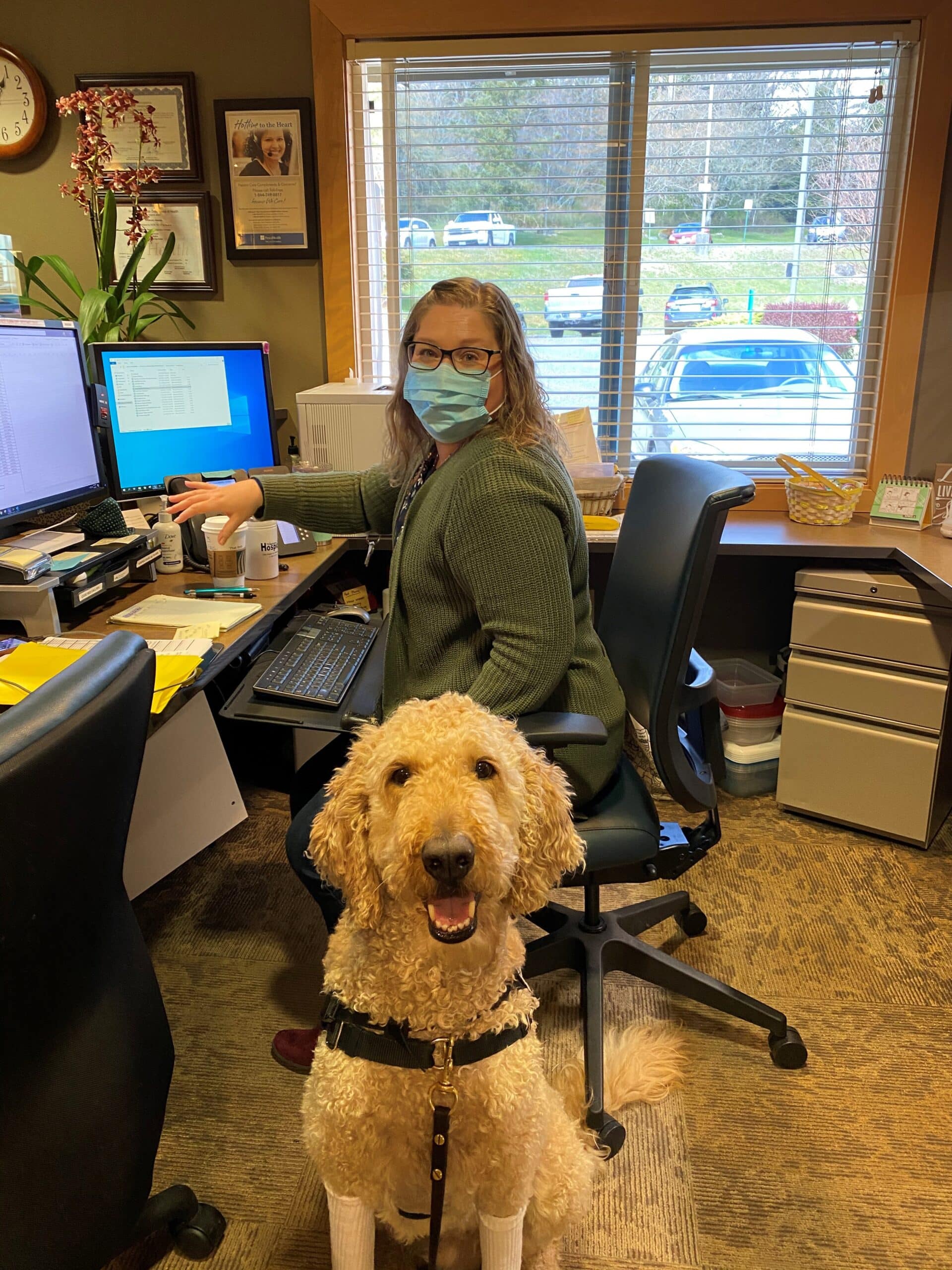
At our hospice, we maintain all the same safety and health precautions that are in place in a hospital setting, and consult with nurses and family before visiting patients. We spend time in common areas with family and friends of patients. We spend time at the bedsides of patients, taking care that a dog lifting his paw to touch someone doesn’t tear delicate skin. We train our animals to maintain a consistent, calm demeanor in a variety of circumstances. And of course, our hospice staff also benefits from Tashi’s presence. As with most therapy animal teams, Tashi is often greeted first by the staff, after which I am acknowledged. No problem for me, and Tashi is all the happier, being the center of attention.
All of this seems comparable to the therapy animal team hospital experience.
Perhaps because of my long experience with hospice, it never occurred to me that it might be an odd match to bring a therapy dog into the hospice setting. The hospice administrative team loved the idea, and Tashi and I started working at our twelve-bed facility soon after we passed our Pet Partners evaluation. I did the intensive hospice volunteer training again, so that I could see it from the perspective of a therapy animal team at the hospice house, after having worked many years in the community without a dog by my side.
I understand that without firsthand experience of hospice, there can be misconceptions about what hospice is and who it serves, and that could make it difficult for someone to imagine what a therapy animal team might do in that
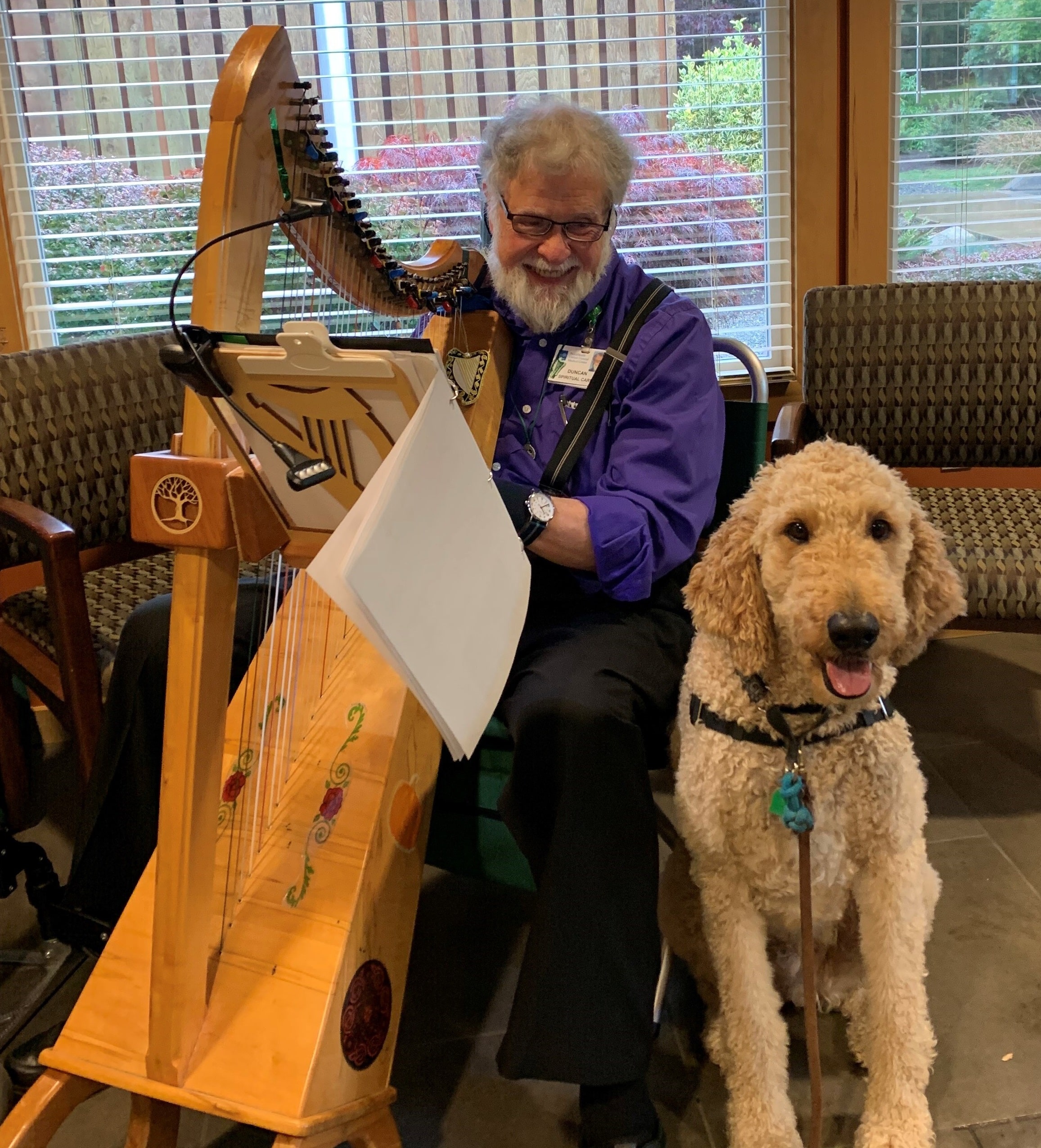
context. I think a common perception is that you go on hospice to die, and that the atmosphere at a hospice facility must be rather depressing. This concept stands to reason, since our culture is somewhat allergic to thinking or talking about death. It is true that a patient must have a six-month prognosis to be eligible for hospice care, but it is also true that many people outlive those six months because their quality of care improves. The intention of hospice is to provide the highest quality of life during the last stage of life.
It might come as a surprise, but our hospice house (much like most such facilities, I imagine) is quite a lively place. It is as homey as a medical facility can be; the rooms are comfortable, and include a day bed if loved ones want to stay over. Every patient’s bed has handmade quilts. Each room has a private outside patio with picnic table and chairs. Bird feeders hang near the windows and there is a fountain in a lovely garden area that can be seen and heard from patient rooms. The hallways and shared spaces have original art on the walls; there is a family room with a fireplace, several intimate places to gather or rest, and a small kitchen where fresh soup and house-made cookies are offered daily. Of course, there is sadness, but there is also love and laughter and warmth.
As for being a therapy animal team at hospice, allow me to take you into this world for a moment.
Tashi and I visited a young man with a glioblastoma at our hospice house many times over the weeks he was there, and we pretty much met his entire family. His mother was there daily, and several siblings visited from across the country over a period of several weeks. Tashi was pleased to visit everyone, and made a point of interacting with the patient and the whole family, offering himself to each person by sitting close enough to have his head and back stroked. As this young man’s disease progressed, he went from being interactive, to sleeping most of the time, to what is called active dying. On most visits his mother was at the bedside, touching her son frequently. The last time I visited, she was sitting on the daybed, about eight feet from her son’s hospital bed. I felt a vast distance between the two as I entered the space.
The mother smiled when she saw us and invited us in. Tashi and I sat beside her; we spoke softly while she stroked Tashi. Suddenly, Tashi got up and went directly to the young man’s bed, stretching his leash (and my arm) to its maximum distance. Nothing I could see had changed with the young man’s body or breath, but Tashi was very specific in his movement towards the bed. I looked at the mother and said perhaps I would say hello to the young man.
I went to the bedside and said hello, telling him Tashi and I had come to visit. After a minute, his mother came to the other side of the bed. She stroked her son, and decided to give him a massage. There was lavender oil, and as she started to gently massage his arms, his chest, his legs, she told me how much her son loved to be touched when he was a child. We sat there, on either side of her son’s failing body, while she told me stories about him. It was such an intimate, sacred moment; I was honored to be there. I don’t know what Tashi saw or felt, but it was clear that he had physically brought us all into the moment, by the bedside, where the connection was tender and deep.
For the human partner in the therapy animal team, hospice is different from many other visit settings because of the frequency with which a casual conversation can become deep and intimate. Specific training is required to become a hospice volunteer. It emphasizes death as a natural event that is a part of life, and focuses on the specific needs of patients at end of life and how to navigate that world with compassion. With additional training in vigiling, we may be asked to sit at the bedside of actively dying patients who don’t have family nearby.
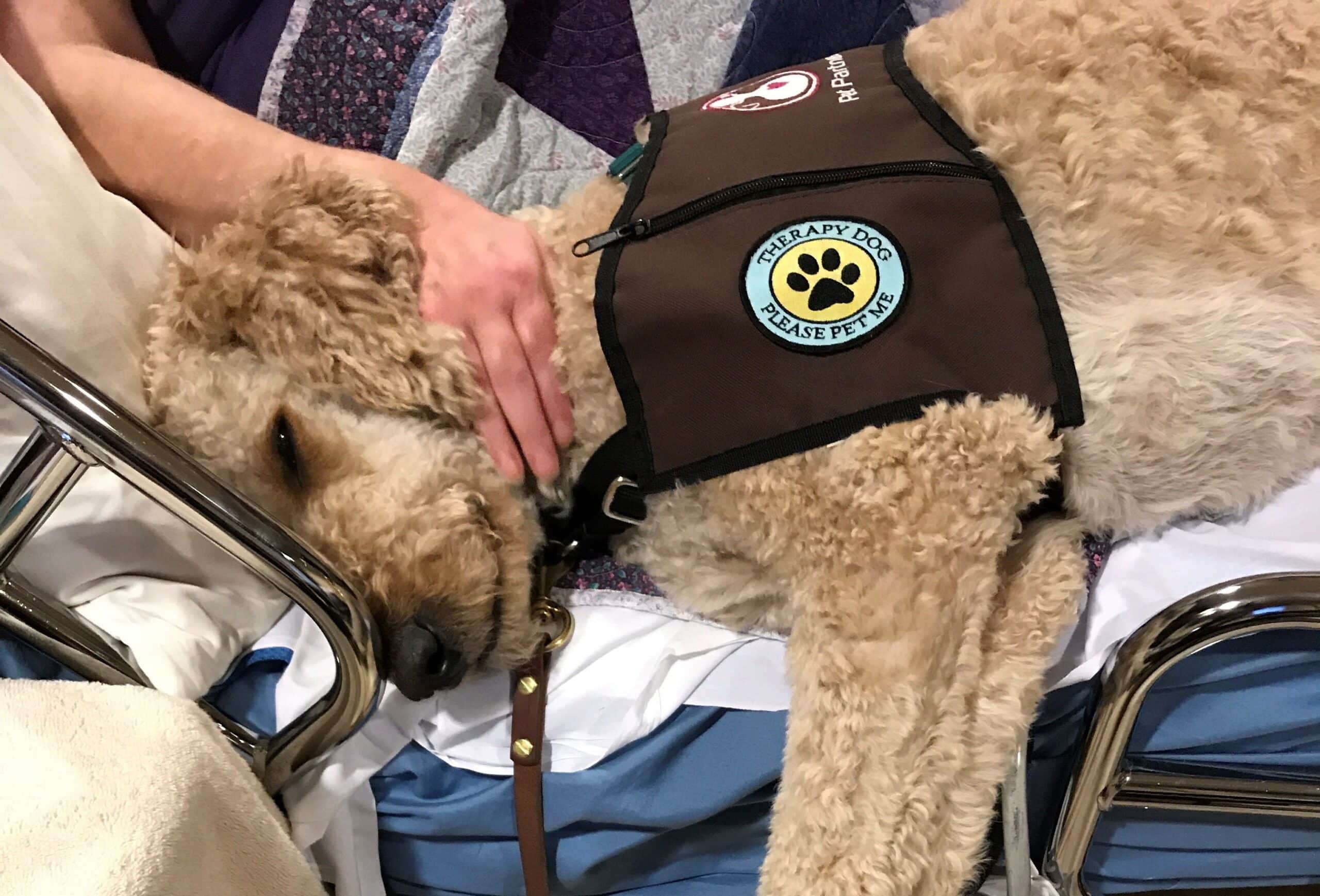
From Tashi’s perspective, I don’t think it makes a bit of difference where we work. As social beings suited to therapy work, our animal partners respond to the love that people bring to the table no matter where they are. Tashi is truly an asset in my work, since he announces my willingness to be present for others. He provides a natural way to connect, and often provides a transition to deeper conversation. I could do this work without him, but it is so much richer with him by my side, and it brings me joy to see him give people comfort when they are at their most vulnerable. Animals, especially dogs, attune readily to human emotions. He is as much my teacher as I am his handler in this journey we share.
Caryn and Tashi have been a registered Pet Partners team since 2017. Caryn presents regular stories about Tashi’s day-to-day life at dogbloggery.com.
We want to tell more stories from Pet Partners handlers about visiting in a variety of facilities. We’d love to hear from you about your experiences. We’re particularly interested in stories about settings that are less common, or where people are surprised to see a therapy animal team.